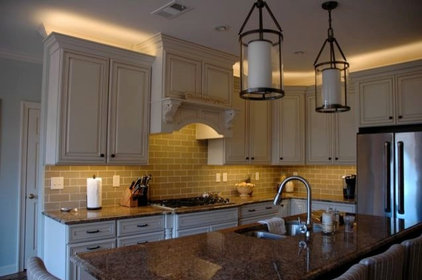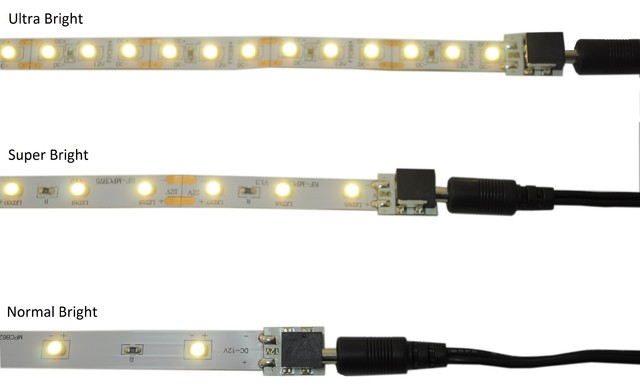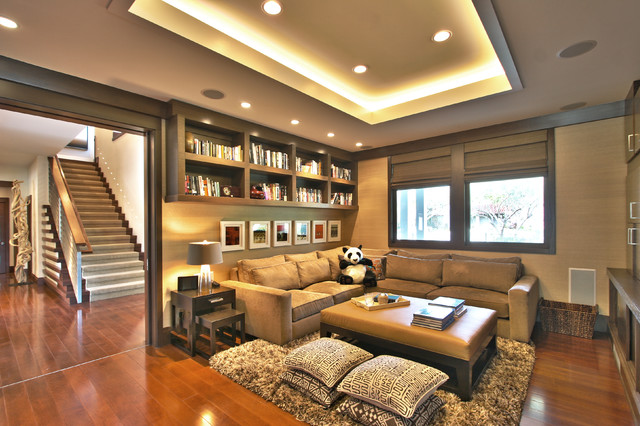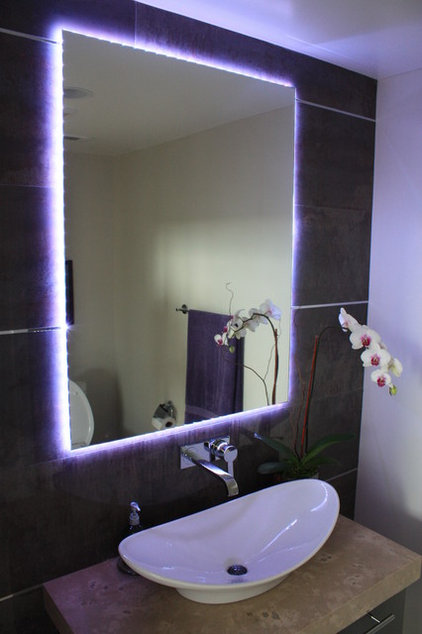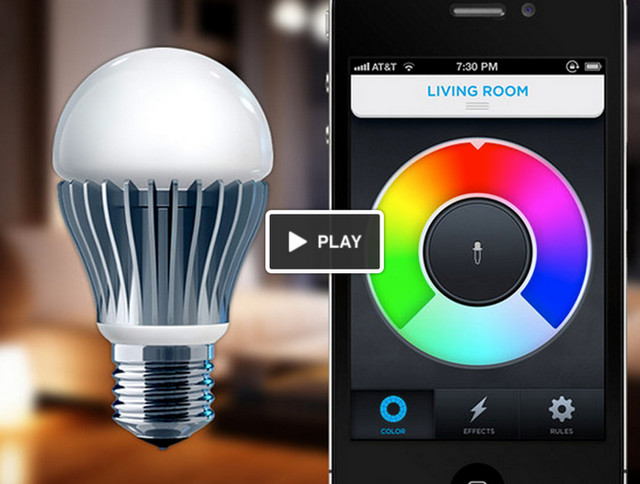The Lowdown on High-Efficiency LED Lighting
Though the upfront cost ($40 to $80) is much higher than for traditional bulbs, the return on investment comes with lower power bills, longer-lasting bulbs and better-quality light. LEDs can last up to 25,000 hours and use 75 percent less energy than traditional incandescent bulbs.
But the best part is their versatility. LEDs cover the range of light, from soft and warm to crisp and cool, and come in various design options that let you play around with neat lighting schemes. LED tape, panels, pucks, ropes, cans and bulbs work wonders with uplighting, downlighting, accent lighting and more.
Here’s a rundown of the basic LED options you can use to illuminate your living space.
LED tape illuminates this kitchen in two color temperatures. Above the cabinets an LED tape described as "normal bright" casts a white glow, while warmer white tape shines under the cabinets.
|
|
|
LED tape is a flexible circuit
board with attached LED chips that can be cut to size. The chips are
dots of light spaced approximately every 5/8 inch; they come in
different levels of brightness. The strips have a self-adhesive backing,
making them easy to install almost anywhere.
|
|
by Inspired LED
»
|
|
Ultrabright flexible strips are perfect for under cabinets, in offices and in other areas requiring a great amount of light. Superbright is the middle range of brightness and works great in spaces that need some light but not too much. Normal bright
is perfect for accent lighting, such as for above cabinets, inside
cabinets, in coves and around toe kicks, and for lighting art and more.
|
When considering tape for kitchen and bathroom applications, it's a good idea to go with coated tape. It is more durable where chips are exposed to heat, moisture and food spills. Noncoated tape works best in areas such as inside cabinets where the chips aren’t exposed to damaging elements.
The cost of a decent-quality LED tape is about $8 to $10 per foot plus the cost of a driver to power it, which starts at $150.
|
|
|
Tape lighting under this vanity gives the vanity the appearance that it's floating in space. Tape
is ideal for illuminating small spaces such as coves, niches and under
countertops. It has a higher lumen output (brightness) than LED rope
lighting.
|
Strips backlight this mirror above and below, creating a soft but dramatic look. Because of an additional covering, strip lights are moisture resistant, which makes them a great choice for lighting a bathroom vanity.
LED strips come in 10-, 20- and 40-inch lengths and range in price from $99 to $200, depending on length and quality.
|
by Urban Colony
»
|
|
Strips lights give this ceiling cove crowning the room a soft glow. Strips can do double duty as accent and overhead lighting because of the high lumen output.
|
|
by SKG Renovations
»
|
|
LED Puck Lights
Under this kitchen cabinet, six energy-saving LED recessed puck lights illuminate the countertop work area while highlighting the quartzite backsplash. LED puck lights are a great replacement for xenon puck lighting fixtures, which give off heat. |
|
Puck lights work well under cabinets, inside cabinets and in niches. The
discs come as battery-powered or plug-in units, sold individually or in
kits in a wide range of prices, from about $10 to $80.
|
|
by WAC Lighting
»
|
|
Color-Changing LEDs
Color-changing LED tape in this ceiling cove casts different hues around the perimeter of the room. The lighting transitions from white to warm amber, much like the sunlight does as it cycles from day to evening. |
|
by Inspired LED
»
|
|
Color-changing tape works with a
remote control to change the colors. You can program color-changing tape
(also known as ribbon) to stay a certain color, fade in and out, flash
or even sync with music.
|
The average cost for a decent-quality LED color-changing system is $500 for 17 feet with a controller and driver.
See a home that goes all-out with colorful LEDs
|
LED Rope Lights
Rope light illuminates this family room's tray ceiling. |
|
by WAC Lighting
»
|
|
Rope lighting works well for
outdoor applications, because it's encased in a durable plastic tubing.
It's perfect for patios, railings, walkways, stairs and landscape
edging.
|
Recessed cans are available as self-contained modules with the LED light built into the housing or a simple LED recessed can lightbulb. An LED recessed can module has its own engine to remove heat, so it lasts longer and produces better-quality light than simple LED bulbs.
A high-performance LED module costs about $80, and an economy module is about $45.
|
by Kickstarter
»
|
|
LED Smart Bulbs
The latest LED product to come on the market is known as the smart bulb, because you can control it from your smart phone, tablet or Wi-Fi network. With apps and products like the Philips Hue Lightbulb and others still in the works you can change the color and brightness of the bulb and set different lighting effects. Because LEDs come in all colors of the spectrum and are highly customizable, the possibilities are limited only by your imagination. |
